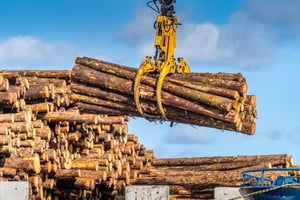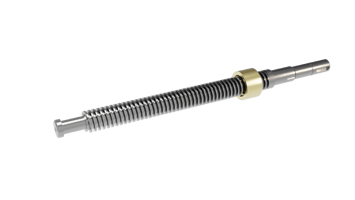Discover the critical differences in efficiency between ACME screws and ball screws in actuator...
Mastering Precision: The Art of Ball Screw Manufacturing
Dive into the meticulous world of ball screw manufacturing, where precision shapes efficiency and performance in machinery.
.png?width=1584&height=396&name=Untitled%20design%20(7).png) Understanding Ball Screw Mechanisms
Understanding Ball Screw Mechanisms
Precision ball screws are essential components in many industrial machines and equipment. To understand their mechanisms, it is important to grasp the basic principles behind their operation. A ball screw consists of a screw shaft and a nut assembly, with steel balls inserted between them. The screw shaft has helical grooves that act as tracks for the balls, allowing them to recirculate within the nut assembly as the screw shaft rotates. This design enables the conversion of rotary motion into linear motion, providing precise and efficient movement in various applications. In Figure 1.0, the RACO Actuator is cutaway to show the screw shaft and nut assembly.


Another important aspect of ball screw mechanisms is the concept of lead, which refers to the distance the nut assembly moves axially for each complete revolution of the screw shaft. The lead determines the speed and efficiency of the linear motion generated by the ball screw. Additionally, the number of balls and their size also play a crucial role in determining the load-carrying capacity and smoothness of operation. Understanding these fundamental mechanisms is essential for optimizing the performance of precision ball screws.
ACME Screws Versus Ball Screws
The rotational movement produced by the electric motor will be converted into a linear movement by acme or ball screws installed within the thrust unit. Acme screws can be made self-locking by selecting a low lead. Static loads, which can be higher than the nominal thrust, can be safely maintained in all positions. Different leads for the screw can be easily produced to have lower or higher rod speeds. Higher leads, however, do not have the self-locking feature, so the cylinder will be equipped with an electro-magnetic brake to maintain position. Ball screws have a rolling friction versus the sliding friction of acme screws. The use of ball screws results in a higher duty cycle, longer lifetime, and better positioning. Each position can be achieved with a high degree of accuracy, and a fast acting motor brake ensures repeatability since ball screws are not self-locking. Due to the efficiency of RACO ball screws of higher than 95%, the capacity of the drive motor can be reduced and smaller motor starters and controls can be used, thus yielding additional savings. A ball screw should also be used when a safety application requires the cylinder to automatically run to a defined position in the event of a power failure.
Materials and Technologies in Ball Screw Fabrication
RACO machines and fabricates its own ball screws for use in their actuators. The choice of materials and manufacturing technologies greatly affects the quality and durability of ball screws. High-grade materials, such as hardened steel or stainless steel, are commonly used for the screw shaft and nut assembly to ensure strength and resistance to wear. The balls are typically made of high-quality steel or ceramic materials, which provide smooth rolling and long service life.
In terms of manufacturing technologies, precision machining techniques are employed to create the complex geometries of ball screws. CNC (Computer Numerical Control) machining allows for precise control of the dimensions and tolerances of the screw shaft, nut assembly, and balls. Advanced grinding and honing processes are also utilized to achieve the desired surface finish and accuracy. These materials and technologies work together to produce ball screws that meet the demanding requirements of precision applications.
The Critical Role of Precision in Ball Screw Performance
Precision is paramount in ball screw manufacturing, as it directly influences the performance and reliability of the final product. The tight tolerances and precise dimensions of the screw shaft, nut assembly, and balls ensure smooth and accurate movement with minimal backlash. Even slight deviations in these dimensions can lead to reduced efficiency, increased friction, and compromised precision.
In addition to dimensional precision, the alignment and assembly of ball screws are critical for optimal performance. Proper alignment ensures that the screw shaft and nut assembly are perfectly aligned, minimizing the introduction of unwanted forces and ensuring smooth operation. Precise assembly techniques, such as preload adjustment, ensure that the balls are loaded with the optimal amount of force, preventing excessive play and enhancing the overall performance of the ball screw system.
The critical role of precision in ball screw performance cannot be overstated. Manufacturers strive to achieve the highest levels of precision in every aspect of the manufacturing process to deliver ball screws that meet the exacting requirements of precision applications.
Innovations and Advances in Ball Screw Manufacturing
Over the years, there have been significant innovations and advances in ball screw manufacturing, leading to improved performance and expanded capabilities. One notable advancement is the development of high-precision ball screw manufacturing techniques. These techniques allow for even tighter tolerances and more precise control of dimensions, resulting in enhanced accuracy and repeatability.
Another innovation is the use of specialized coatings and surface treatments to improve the performance and longevity of ball screws. These coatings reduce friction, minimize wear, and provide corrosion resistance, extending the lifespan of the ball screw in harsh operating conditions.
Furthermore, advancements in materials science have led to the development of lightweight and high-strength materials for ball screw components. These materials offer improved efficiency and reduced energy consumption while maintaining the necessary strength and durability.
The continuous drive for innovation and improvement in ball screw manufacturing ensures that precision machinery can operate at peak performance, meeting the ever-increasing demands of modern industries.
Quality Control and Testing in Ball Screw Production
To ensure the highest level of quality and performance, rigorous quality control measures are implemented throughout the ball screw production process. Advanced inspection techniques, such as coordinate measuring machines (CMM), are used to verify the dimensional accuracy of the screw shaft, nut assembly, and balls. These inspections ensure that the components meet the specified tolerances and are free from defects.
In addition to dimensional inspections, functional testing is conducted to evaluate the performance of the ball screws. This includes testing for smoothness of operation, backlash, and load-carrying capacity. Specialized testing equipment is utilized to simulate real-world operating conditions and verify the performance characteristics of the ball screws.
Quality control is not limited to the final product but also extends to the entire production process. Stringent process controls are in place to monitor and optimize each step, from material selection to machining and assembly. This comprehensive approach to quality control ensures that every ball screw leaving the manufacturing facility meets the highest standards of precision and reliability.



